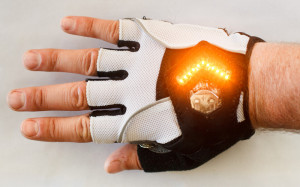 We wrote recently about the teched-out bicycling gloves being developed by Zackees. Company founder Zach Vorhies, whose Kickstarter went live today, has written an exclusive for Wearable Tech Insider about how you get from wearable art to a wearable product.
We wrote recently about the teched-out bicycling gloves being developed by Zackees. Company founder Zach Vorhies, whose Kickstarter went live today, has written an exclusive for Wearable Tech Insider about how you get from wearable art to a wearable product.
Here’s Zach:
The most important question when you get from artistic clothing to something practical is: “What problem are you solving?” – as you would in any new tech venture.
A lot of the artistic clothing that I was making as a hobby just didn’t solve any important problems, and that’s the key to innovations that are useful – they solve problems.
Originally I wanted to make something called the HydroPak, which is like a Camelbak but it pulses light when it hears music. That’s awesome for a runway or hanging out at a festival with friends but it didn’t really solve any novel problems. Essentially it was just a Camelbak that was more aesthetically pleasing.
I finally realized that I needed to create something else when one of my mentors, Robert Moll (www.patentplanet.com), evaluated the HydroPak as an idea. His question was: “What problem does the HydroPak solve?” I couldn’t really answer that question well.
From then on, whenever I came up with a wearable design idea I would ask myself that question, “What problem is this solving?” When I thought of the Turn Signal Glove, I realized that it solved the very important problem of bike rider safety. I built a prototype the next day so that I could show other people and see what they thought. The general response was, “this is great!” and “why doesn’t this exist already?”
That’s when we knew we had something special on our hands… literally.
I started off as a Google software engineer who made electronic clothing as an art and a hobby, to making electronic clothing as a profession.
How did I get here? Well, first, I actually wanted to make my HydroPak the first design that I was going to try to produce and sell. However I was dissuaded when one of my mentors, Robert Moll (patentplanet.com), sat down to talk about possibilities of patenting the technology. After seeing the HydroPak he was convinced that it was art and not a something novel or useful enough to be covered with a utility patent. The key question of patentability that Robert shared was “What is the problem that one is trying to solve?” This was a huge learning moment for me.
From then on I was looking for what problem wearable technology could solve and before long I realized, as a cyclist, that visibility is the problem I should attempt to solve. Cars just don’t see cyclists and the results are often fatal. I know several friends that have been in serious accidents while cycling. So I set out to create a product that made cycling safer by giving cyclists what they are missing, Turn Signals!
This was the point when art transformed into a practical product.
I called on a friend, New York fashion designer Wheyland Dean-Ford to help me out. I did the electronics, Wheylan did the clothing design. The first wearable turn signal was actually on a t-shirt! But that turned out to be a total failure because wires had to run from the turn signals mounted on the shoulders all the way to the hands which was uncomfortable. Also the shirts need to be washed all the time because they get smelly. I considered a bunch of other options and the glove just seemed like the best choice – simple to use and affordable to the consumer. So we made our first Turn Signal Gloves and showed it off. The reception was incredibly strong and we knew that we had a hit on our hands.
So I think solving a problem is crucial when you go from one stage – art – to the next – practical, where the tech and the design merge to create something functional and new.